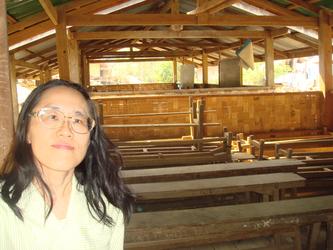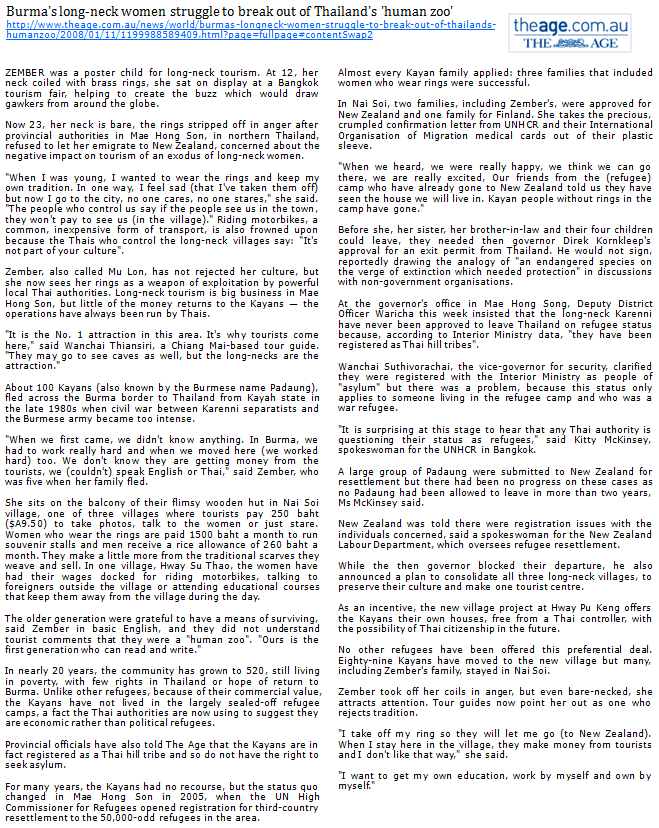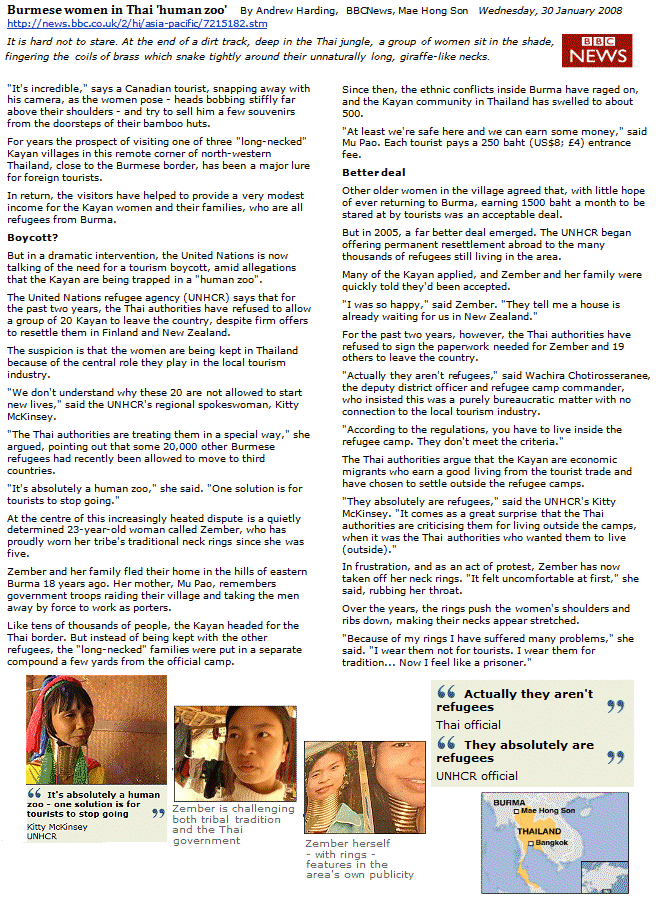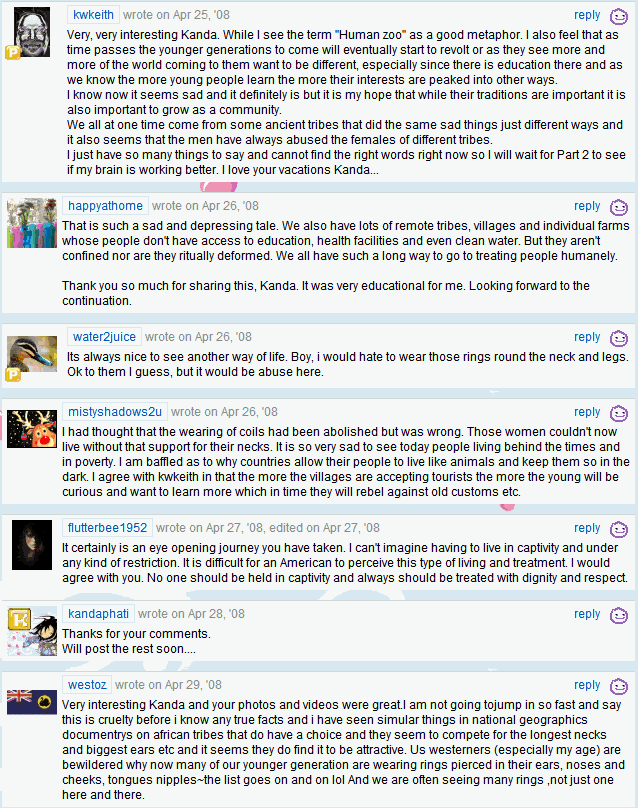My Old Blogs at Yahoo!360 / MTP
Family Trip to Mae Hong Son in April, 2008: Part I
Apr/25/2008
* Notes:
– A table with white background was added for easier viewing. (Apr-28-2008)
– Reposted at Webs.com. (Nov-27-2010)
– Slideshows at webshots were gone.
– Re-coded and posted at Neocities.org on Jul-1-2017.

My Lengthy Report of Our Visit to the Long Necks and the Big Ears
We first drove to Mae Hong Son in December, 2004 at the time when there were tsunami in the south of Thailand. It was quite a surprise to see the long neck and the big ear tribes with our own eyes.Before that I had not known much about them except that they had fled to our country because of wars in Myanmar, or Burma, and upon entering Thailand they were put to shelter area or refugee camps along the Thai-Myanmar border.
Many of these people could not have higher education or better work. Some of them were trapped in human zoo BUT they might have income from selling souvenir or whatever.
I feel it unfair that we could go to their villages whereas they were not allowed to come to our city.
I later found out that only the long neck and the big ear tribes were transferred to sightseeing villages while other Karenni tribes were restricted in refugee camps.
This Songkran we went to Mae Hong Son for the second time. It was midsummer. I remember our tour guide in 2004 told us Mae Hong Son was cold in winter and very, very hot in summer. And indeed it was very hotttttttttt!
We took a lot of pictures and videos during our 7-day trip.
When I returned I sorted the pictures and had questions about the long neck tribe so I did some research on the internet. The articles that I found saddened me....
Anyway, let me start with our trip to the long neck tribe's village.
On April 16 around noon we left our hotel and followed the road signs that point to "Ban Nai Soi long neck tribe". We left the city of Mae Hong Son and entered a small winding paved road that sometimes went through thickly populated area. The paved road eventually gave way to narrow and bumpy dirt road up the hill. As our car was not a pickup truck or SUV I was a bit worried.
While we proceeded at an uttermost slow speed fearing that our car would break down we saw a few cars go faster than us. These must have been driven by those that were familiar with the place. We were dumbfound upon seeing two long neck young women riding a motorbike passing by! The car crossed a narrow bridge over a small stream where there were young boys and long neck girls bathing and swimming. The boys looked "normal": there were no metal coils around their necks.
We reached an open space in front of a huge refugee camp. The long neck tribe's village was next to the camp. In fact, these two places shared one fence. I wondered why the two were so close.
We talked to the two officers at the information hut. They said the camp had 20,000 refugees and it was not open to tourists. I asked if the long neck people had Thai citizenship. They answered those that had entered Thailand before Buddhist year of 2528 (= the year of 1986) were given IDs of hill tribe people. This means they have to get permission from the authority if they want to leave the region (or prefecture? I am not sure here).
I do not understand why hill tribe people cannot travel freely within our country.
1. At the parking lot.
2. The entrances.
3. Sign on the right - enlarged:
4. Sign on the left - enlarged:
5. At the information.
6. We could not enter the refugee camp.
7. The entrance to the village.
8. Ken and a girl from the village. She was cute but I feel sad for her.
9. Ken, the girl, and her mom.
I wonder if the little girl will grow up to be like her mom - confined in the village.
10. Inside a shop in the village.
11. View in the village. Do they have electricity?!?!
12. Another "shop".
13. Posters
14. Their "hospital".
15. Inside the hospital. There is only one room. This is it.
16. The school.
17. School office - or, the teachers' room.
18. With the village's doctor. She is of the Red Karen's tribe.
We took pic with a lady who said she was a doctor. She had no coils on her neck. She said she was of Red Karen's tribe from Burma and had been living in Ban Nai Soi refugee's village for 19 years. She could speak Thai, English, Burmese, Karen's language, and maybe some other more.
When asked why she did not return to her home country, she said in Thai, "The Burmese soldiers were bad."
She told us the children in the village learned 4 languages at school.
19. Inside a classroom.
20. The classroom.
21. Tourists' writings - perhaps.
22. School activities.
23. School activities
24. A Big Ear Tribe lady
25. Ken with the Big Ear Tribe lady
26. Another Big Ear Tribe lady
27. With a Big Ear Tribe granny
28. At a donation box in the village
29. The village
There was a church in the village. It was a Catholic church. But does it matter which nomination it was...? I was glad the villagers had a place to pray and to let their hope live.
30. Inside the church.
31. View of the village from the church.
32. Inside the church.
33. The church viewed from outside.
There were many souvenir "shops" in the village.
It was rather quiet and the villagers were resting in their living quarters behind the shops as it was very hot in the early afternoon with hardly any other tourists except us visiting the village.
Sometimes when we entered a shop, a little girl of no more than 8 years old would appear from the back of the shop, which was the living room of her family, and did her job as a sales person. These little ones were either from long neck tribe or big ear tribe.
Other tribes (those that had no coils either on their necks or ears or legs) were not seen here except the village doctor that I had talked to.
I did not see any boys helping with the shops.
34. A penned pig.
35. Big Ear Tribe mom and daughter.
36. A Big Ear Tribe little girl.
37. The Big Ear Tribe little girl at her shop.
38. Two Long Neck Tribe children.
39. Souvenir shops.
40. Inside the village.
41. Ken with a Long Neck Tribe young lady.
42. Sompote in the scene.
43. Tooo hotttt!
44. The road back to the world outside.
Video of a little girl demonstrating a tribal musical instrument:
http://youtu.be/jEqriX7VRhc
Video of what some young boys in the village did for fun:
http://youtu.be/japJ8l4BB7A
On April 17, after the elephant ride we went to another long neck tribe's village in Huay Sua Tao. We first went there in 2004 but did not have any long talk with the villagers.
Like Ban Nai Soi, there were long necks and big ears living in the same village. We spent a while talking to a very good looking long neck tribe's girl. She was returning from the woods after having carried food and water to their men who went there getting things for the villagers. This 17-year-old girl spoke Thai perfectly. She told us she and other village kids went to Thai school outside the village as the village compound was too small to have any school. She said the kids in Huay Sua Tao did not have a chance to study their own language(s) as Thai schools did not teach these.
I am not sure if these tribal kids are allowed to continue their higher education in universities either in town or in other cities. I hope they could.
Pics here: Long Neck Tribe in Huay Sua Tao (April-17-2008, 14 pictures)
The links below were about long neck tribes that I have found on the internet after our trip. They saddened me so much...
Should we accept cruelty in cultures? (*The link does not work anymore.)
"It is done to helpless children who have no choice and who later must come to terms with it and think it makes them beautiful."
Isn't it sad that it has always been women and especially little children that are susceptible to all kinds of cruelty in the name of tradition or culture? They could not and did not know how to say NO.
Another link:
Burma's Longneck Women Struggle to Break out of Thailand's Human Zoo Screenshot below:

I think the article above, which was posted in Jan-12-2008 (only 3 months prior to our visit), has more or less helped to make the long neck tribes have a somewhat better life.
First of all, women were less "confined": when I was there I did see more than three long neck girls riding the motor bikes!
Unlike what the article described, we did not pay any entrance fee before we get into the villages.
We learned that kids in Ban Nai Soi village could study 4 languages in their "school" whereas kids that went to Thai schools outside their confined villages definitely learned at least two languages: Thai and English.
I used the word "human zoo" before I knew BBC had used this very same word.
Read the article here:
http://news.bbc.co.uk/2/hi/asia-pacific/7215182.stm
I firmly believe that no humans should be treated as if they were animals in a circus or a zoo, and while visiting in these sightseeing villages I could not bring myself to staring at them.
While I doubt if it is a good idea to discourage these women from wearing coils and rings as this would be the same as disrespecting their treasured tradition I also felt so sad when I noticed huge bruises on the knees of big ear tribe moms under their shiny brass coils. And anyone could clearly see that the shoulders and rib cages of the older long necks were severely deformed.
Wouldn't it be better if we could ask someone to produce light-weight but durable and easily removable brass-like shiny coils and rings for them to put on? This way necks and knees can still be "decorated" but there won't be harm done on any muscles.
But I do not know how to make ears "big" without making big holes on the earlobes....
In Jan 2008 the UNHCR has recommended a tourism boycott of Kayan villages in Thailand. This is in Wikipedia:
http://en.wikipedia.org/wiki/Kayan_%28Burma%29
Screenshot below:

Sad!
One of my friends said, "It is similar to a ZOO insofar as they are trading a spectacle. I even hate elephants being held in captivity!"
I could not agree more although these days it is very difficult to let elephants live comfortably by themselves in jungles as there is not enough food for them!
Instead of simply boycotting tourism to these villages wouldn't it be better if we could offer our help to improve these people's quality of life?
Not all countries or cities really welcome refugees so the best thing is to help them to stop being one.
In the high mountains of Mae Hong Son and Chiang Rai there are a few Chinese refugee's villages that have always attracted lots of tourists from all over the world but these places do not give the feeling of human zoos.
Though a few villagers may wear traditional costumes that are exotic in outsiders' eyes the main attraction is not there.
Rather, tourists visit these remote places for delicious Yunnan cuisine, tea (there are lots of tea plantations and factories up there!), coffee, fruits (both fresh and preserved), handicrafts, goods imported from China, and beautiful scenery.
There are memorials and museums in the villages to remind everyone of the long and difficult way from the sad and brutal past.
There are good resorts and hotels, too.
The villagers have steady and sufficient income, security, dignity, and hope. They also enjoy better health. Their younger generations are accessible to better education.
If the Chinese could make it there is no reason why the long necks and the big ears cannot also make it.
I wish everyone in these tribes, while they are in Thailand, can live peacefully, happily, and gracefully without having to lose their dignity or identity.
I am sure many good projects have been carried on for their sake. I also believe that more humanity work is still needed and how I wish I could take part in it.
– End of part one –
← Previous
Next Blog →
The Top The List Kanda's at Neocities.org

